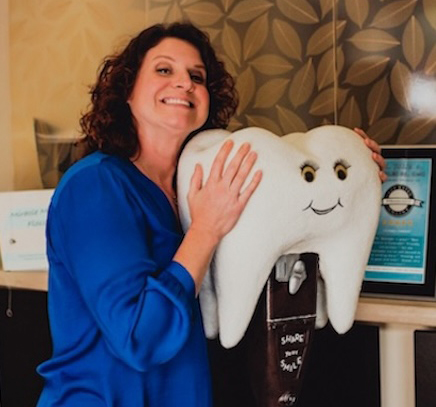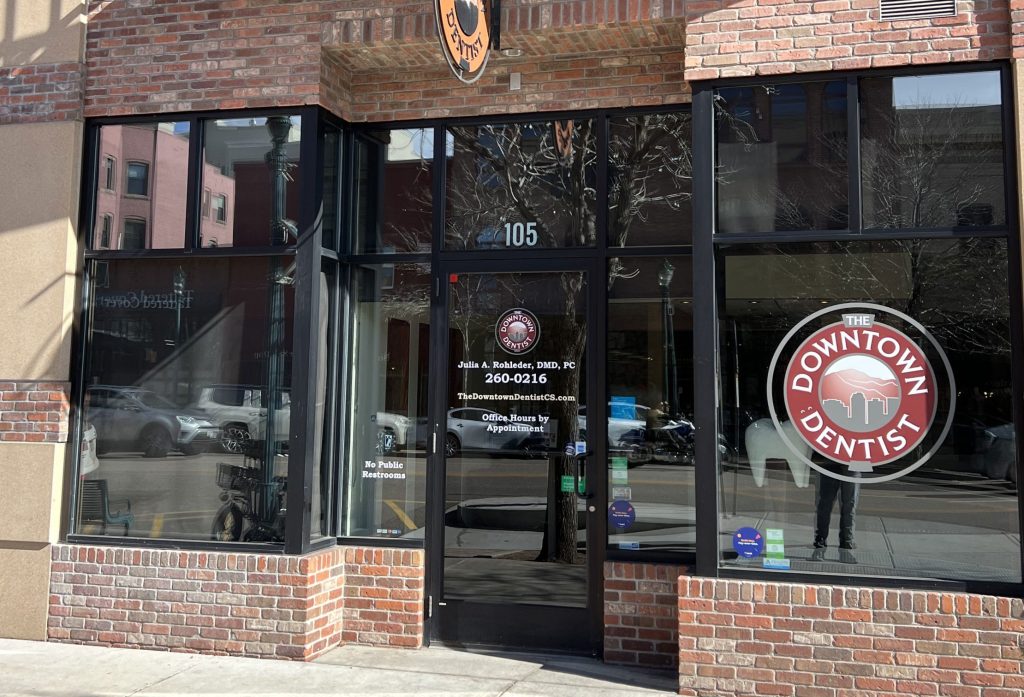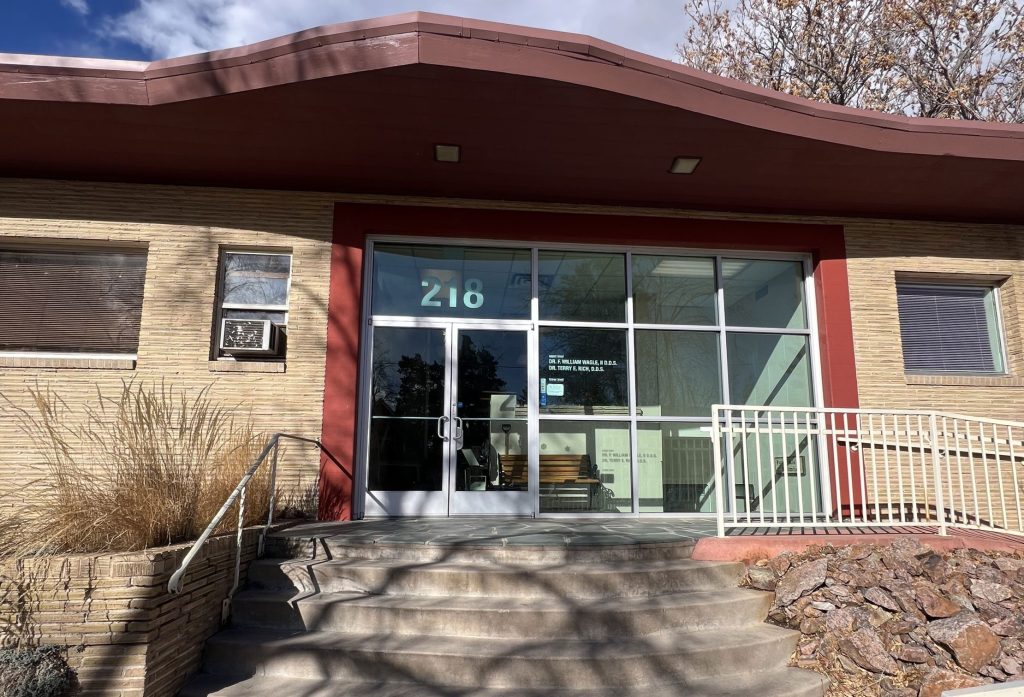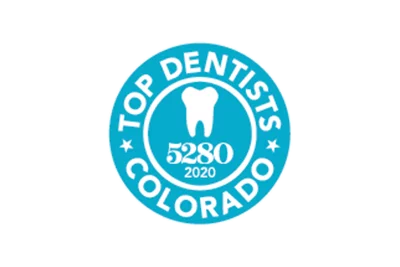Dental Crowns

Dental crowns play a vital role in restoring damaged or decayed teeth. Dental crowns are incredibly versatile, and offer a long-lasting solution to various dental issues. If you’re considering dental crowns or want to learn more about the different types of crowns, you can count on our team at The Downtown Dentist in downtown Colorado Springs.
What are the different types of materials used for dental crowns?
Different materials used for dental crowns include porcelain, metal, ceramic, and composite resin. Each material has its advantages and is chosen based on factors like durability, aesthetics, and cost. Our team will recommend the best option based on your specific needs and preferences.
Understanding Dental Crowns
Dental crowns, also called caps, are fixed prosthetic devices cemented onto existing teeth or dental implants. They are designed to fully encase the visible portion of a tooth above the gum line, restoring its shape, size, and function. They are often recommended for teeth with extensive decay or damage that cannot be effectively treated with fillings or other dental restorations.
Why Would You Need a Dental Crown?
Dental crowns are essential for restoring severely damaged teeth that can’t be fixed with regular fillings. They offer protection and support to weak teeth, preventing decay and potential tooth loss. Crowns are recommended post-root canal therapy to strengthen teeth and prevent fractures. They also support dental bridges and cover teeth with large fillings that have weakened the structure.
Exploring the Different Types of Dental Crowns
Dental crowns come in various types, each with its own unique features and advantages.
The Temporary Crown
During the dental crown procedure, a temporary crown may be placed on your prepared tooth while your permanent crown is being fabricated. Here are some key points about temporary crowns:
- Temporary crowns serve as interim restorations.
- They protect the prepared tooth until the permanent crown is ready.
- Temporary crowns are usually made from acrylic or stainless steel.
- They provide functionality and protection during the waiting period.
It is important to follow The Downtown Dentist’s instructions for caring for the temporary crown to ensure its durability.
The One-Day Crown
One-day crowns, also known as same-day crowns or CEREC crowns, are a modern dental technology that allows for the fabrication of crowns in a single dental visit. Here’s what you need to know about one-day crowns:
- Same-day crowns are designed and manufactured at The Downtown Dentist using advanced CAD/CAM technology.
- The crown is milled on-site and can be placed on the same day as your dental visit.
- This eliminates the need for temporary crowns and multiple dental appointments.
- One-day crowns offer convenience, efficiency, and excellent aesthetics.
- With one-day crowns, you can leave our office with a permanent crown in just a few hours.
Onlay or 3/4 Crown
Onlays, also known as 3/4 crowns, cover only a portion of the tooth, as opposed to fully encasing it. Here’s what you should know about onlays:
- Onlays restore teeth with moderate damage or decay.
- They are similar to dental crowns but preserve more of the natural tooth structure.
- Onlays are often used when a tooth has a large filling or needs additional support.
- They can be made from various materials, including porcelain, resin, or ceramic.
- Onlays provide a conservative alternative to full crowns, offering durability and aesthetic appeal.
The Procedure for Getting a Dental Crown
A dental crown involves a multi-step procedure that spans one or more dental visits. Here’s an overview of the dental crown procedure:
The Multi-day Procedure with Temporary Crown
The procedure for getting a dental crown involves two dental visits. During the first visit, the experts at The Downtown Dentist prepare the tooth, take impressions, and place a temporary crown. The second visit is when the permanent crown is bonded to the prepared tooth. Here’s what you can expect during a multi-day crown procedure with local anesthetic:
First visit:
- Our team will prepare the tooth by removing any decay or damaged portions.
- The tooth is shaped to accommodate the dental crown.
- Impressions of your teeth are taken to create a custom crown.
- A temporary crown is placed on the prepared tooth to protect it while the permanent crown is being fabricated.
Second visit:
- The temporary crown is removed, and the prepared tooth is thoroughly cleaned.
- The permanent crown is carefully placed on the tooth and checked for fit, shape, and color.
- Once your dentist at The Downtown Dentist is satisfied with the crown’s fit, it is permanently bonded to the tooth using dental cement.
The Same-Day Procedure
Thanks to advanced dental technology, same-day crowns offer a convenient and efficient alternative to the traditional multi-day crown procedure. Here’s what you need to know about the same-day crown procedure:
Step 1: Preparation
- Our team will prepare the tooth by removing any decay or damaged portions.
- The tooth is shaped to accommodate the dental crown, just like in the traditional procedure.
Step 2: Digital Impression
- Instead of taking traditional impressions, our team will use a digital scanner to create a precise digital impression of your teeth.
- This eliminates the need for messy impression materials and provides accurate measurements for crown fabrication.
Step 3: Crown Design and Fabrication
- Using CAD/CAM technology, the experts at The Downtown Dentist will design the crown virtually on a computer.
- Once the design is complete, the experts at The Downtown Dentist use a milling machine to fabricate the crown from a block of dental material.
Step 4: Placement and Bonding
- After the crown is milled, it is checked for fit, shape, and color.
- Once approved, the crown is carefully placed on your prepared tooth.
- The crown is bonded in place using dental cement, and necessary adjustments ensure a comfortable bite.
Dental Crown Care and Maintenance Tips
To ensure the longevity of your dental crown, it’s essential to follow good oral hygiene practices and care for your crown properly. Here are some tips to help you maintain your dental crown:
Taking Care of Your Temporary Dental Crown
While temporary crowns are not as durable as permanent crowns, they still require proper care during the waiting period. Here are some care instructions for temporary dental crowns:
- Be cautious when chewing, avoiding hard or sticky foods that may cause the crown to dislodge.
- Clean the temporary crown carefully while brushing your teeth, using a soft-bristled toothbrush.
- Avoid flossing around the temporary crown, as it may loosen or come off.
- Follow The Downtown Dentist’s recommendations on which side to chew on to minimize the risk of crown displacement.
- If you experience discomfort with the temporary crown, inform The Downtown Dentist immediately for evaluation.
Long-term Care for Permanent Dental Crowns
Proper care and maintenance are crucial to the long-term success of your permanent dental crown. Here’s how you can care for your crown and maintain its durability:
- Brush gently: Use a soft-bristled toothbrush and fluoride toothpaste to brush your teeth, paying extra attention to the gumline around the crown.
- Floss daily: Regular flossing helps remove plaque and debris from between teeth and around the crown, preventing decay and gum disease.
- Schedule regular dental visits: Visit The Downtown Dentist for routine check-ups and professional cleanings to ensure the crown’s health and detect any potential issues early on.
- Avoid chewing hard objects: Refrain from biting on hard objects, such as ice, pens, or fingernails, as they can damage the crown.
- Choose dental care products wisely: Opt for non-abrasive toothpaste and dental floss suitable for dental crowns to avoid scratching the crown’s surface.
The Longevity of Dental Crowns
The lifespan of a dental crown depends on several factors, including material choice, dental care, and individual habits. With proper care and maintenance, dental crowns can last for many years, providing durable restoration. Here’s what you need to know about the longevity of dental crowns.
Factors Influencing the Lifespan of Dental Crowns
Several factors can influence the lifespan of dental crowns. Understanding these factors can help you make informed decisions about your dental care. Here are some key factors:
- Material choice: Different materials have varying durability, and some materials, such as zirconia, are known for their exceptional strength and longevity.
- Biting forces and tooth alignment: Proper biting alignment and balanced chewing forces can help reduce stress on the crown, potentially enhancing its lifespan.
- Dental care habits: Regular brushing, flossing, and dental visits greatly contribute to the overall health and longevity of dental crowns.
- Quality of the crown: High-quality crowns that are well-fitted and fabricated using advanced techniques tend to have a longer lifespan.
- Adjacent teeth condition: The health and condition of the teeth surrounding the crown can impact its durability.
How to Ensure Your Dental Crown Lasts Longer
While dental crowns are durable, proper care and maintenance are essential for their longevity. Here are some tips to help ensure your dental crown lasts longer:
- Practice good dental care: Brush your teeth twice a day with fluoride toothpaste, floss daily, and visit your dentist regularly for professional cleanings.
- Avoid habits that may damage the crown: Avoid chewing on hard objects, such as ice, and refrain from teeth grinding or clenching, as these can damage the crown.
- Protect the crown during physical activities: If you participate in contact sports or activities that may pose a risk of dental injury, consider wearing a mouthguard to protect the crown.
What are the Alternatives to Dental Crowns?
While dental crowns are an effective solution for many dental issues, there are alternatives worth considering. Here are some common alternatives to dental crowns:
- Dental implants: Dental implants are an option for replacing missing teeth. They involve surgically placing an artificial tooth root into the jawbone, which provides support for a crown.
- Dental bridge: A dental bridge is used to replace one or more missing teeth. It consists of crowns on adjacent teeth, with a false tooth (or teeth) in between, filling the gap.
- Dental filling: For smaller areas of decay or damage, a dental filling may be sufficient. Fillings are made from materials such as composite resin or amalgam.
- Dental veneer: Dental veneers are thin shells that are bonded to the front surface of teeth. They can improve the appearance of teeth with cosmetic concerns, such as discoloration or minor chips.
- Onlays: Onlays, also known as partial crowns, are used for teeth with moderate decay or damage. They cover a larger portion of the tooth than dental fillings but are more conservative than dental crowns.
Schedule a consultation, today
Dental crowns play a vital role in restoring and enhancing the function and aesthetics of your teeth. Count on our team at The Downtown Dentist in downtown Colorado Springs to help you take proactive steps towards dental health that lead to a confident smile and optimal oral well-being. Schedule an appointment by calling (719) 260-0216 for our Tejon Street location or (719) 633-3711 for our Willamette Avenue location.

 Dr. Rohleder
Dr. Rohleder Meet the Team
Meet the Team Sterilization Protocol
Sterilization Protocol Frequently Asked Questions
Frequently Asked Questions Careers
Careers












